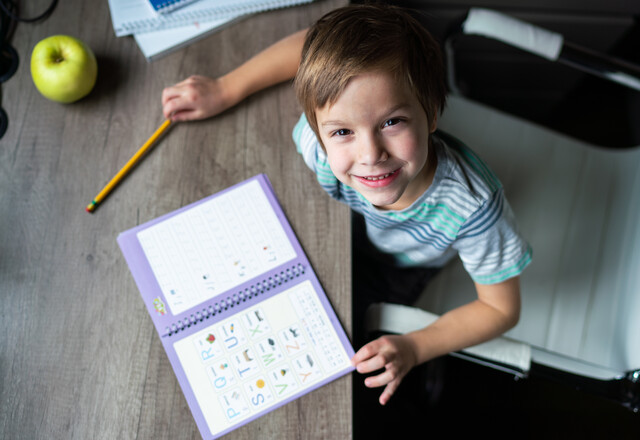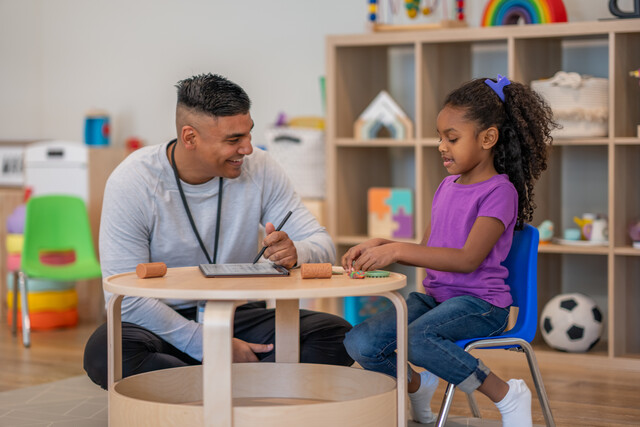Dr. William Glasser developed reality therapy in the 1960s to assist people with various life problems and coping issues. Since its inception, the method has been so successful in helping people achieve life success that it has grown into a worldwide phenomenon. Traditional psychologists use reality therapy in their office practices and it has been modified for use in classroom management and discipline techniques. It has proven to be an effective and humanistic method of helping students achieve their potential; it also assists teachers in helping students realize their wants and needs.
One of the best features of this method is that it is easy to understand and implement. It is logical, humanistic, and uncomplicated. Reality/Choice Therapy focuses on our basic human needs and wants, and uses them to help individuals reach their desired goals. Educators can use this simple method to help achieve their own goals -- a learning-friendly classroom -- and to also help their students reach their personal and educational goals.
William Glasser's first premise is that we have five basic needs that drive, motivate us and, when met adequately, ultimately help us to feel happy and fulfilled in life. According to Glasser, we are all seeking to fulfill these needs on a daily basis, either consciously or unconsciously. Most psychologists and educators have no trouble agreeing upon these five basic needs.
The basic needs are:
- Survival: Having adequate access to food, shelter, clothing, etc.
- Love and Belonging: Feeling a part of a group, feeling accepted by fellow students, co-workers, and other groups, being loved by family and friends.
- Freedom: Independence, self-sufficiency, autonomy.
- Fun: Participating in events or activities that bring pleasure or enjoyment.
- Power: Feeling worthwhile, in command of life direction, mastery of skills, a sense of achievement, feeling successful at tasks.
When anyone, students, or otherwise, use inappropriate or ineffective methods to fulfill one of the five basic needs, trouble usually arises. If we feel unhappy and unsatisfied, chances are one of our five basic needs are not being met. This method teaches that we have no control over others, and others do not have control over us. The only control we have is over ourselves.
Reality/Choice Techniques
Often, we translate the basic needs into "wants." For instance, we may want a student to behave to fulfill our need for power (success in the classroom), but we do not see this as a "need," even though it is. A student may want another student to be his/her friend in class, this desire is driven by the student's need for love and belonging. The student may go to great lengths to secure the friendship. Often, we encounter trouble when what we want/need goes counter to what others want/need. Remember, we do not have control over others, only ourselves. Also remember, a student usually be misbehaving because he or she is attempting to meet their needs in inappropriate ways.
Keeping with the premise of only being able to control one's self, reality/choice therapy can be applied to an educational environment. It is effective because it gives students a "choice" over their behavior, thus, also giving them control over themselves and how they choose to behave in order to get what they want/need. You should also be getting what you want/need, which is a peaceful classroom that encourages learning. The reality/choice method is not overly concerned with the past or "what happened" in the past to create misbehavior or irresponsible behavior; it focuses on the present and the future and helps the individual achieve their wants/needs by changing their behavior and taking responsibility to gain their wants/needs.
Reality/Choice Method Techniques to Classroom Management and Discipline:
- Observe the student's troublesome behavior. Which of the five needs is the student trying to meet with his/her inappropriate behavior?
- Explain to the student that their current behavior will not get them what they want. Suggest an alternative behavior for them to get what they want. Ask them if they know of a better method to get what they want.
- Implement; have the student try the positive, pro-active behavior. Remind him/her they can succeed and have what they want/need, with appropriate action, follow-through, and correct behavior.
- Choice; if the student refuses to try a positive behavior that they come up with, or that you suggest, offer a choice. You can do ABC, or you can do XYZ. Period.
- No excuses. Do not accept excuses for irresponsible behavior, point out to the student that he/she had a choice; she made the wrong choice. Do not punish, criticize, or protect the student from reasonable consequences.
Conclusion
There is a lot of value in reality/choice therapy, particularly for classroom management use. While it is easy to understand and implement, there is a great deal of information on this subject. If you want to learn more, you should read William Glasser's work on the subject. The basic premise of this method is that all human beings are motivated daily to secure their five basic needs: survival, love and belonging, freedom, fun, and power. Depending on the individual, one of these needs will dominate over others and each person will have their own way of attempting to secure these needs. When students use misbehavior to secure their needs, they should be offered a choice and given suggestions on how to better achieve their needs.
You Decide:
A student in Mr. Thomas's class is the comedian. Joseph often makes funny remarks that are witty and even make Mr. Thomas laugh. In the past, he usually did this only during lulls or class discussions. Suddenly, this student has been continually disruptive, this has the effect of making the other students laugh and pay attention to him. However, it is also interrupting the learning process for everyone. What need/want is Joseph attempting to secure? How can Mr. Thomas use the reality/choice method to help Joseph meet his need without disrupting learning?
You Decide Answer:
If you decided that Joseph is seeking to obtain the need of love and belonging, then you are correct. The reason why Joseph has suddenly become inappropriate in achieving this need is unimportant, according to reality/choice therapy. Mr. Thomas should speak to Joseph in private. He should explain to Joseph how valuable his comic relief is to the entire class and how appreciated it is. He should then explain that he is overdoing it by disrupting learning for himself and the rest of the class. Mr. Thomas should let him know that joking is ok during lulls and during class discussions, but also gently let him know that he will have to take corrective action if Joseph continues to disrupt learning. If Joseph continues, he will then have to be presented with a choice. Stop disrupting learning with joking, or leave the room until lessons are over.
Teacher Effectiveness Training, also called T.E.T., was created by Dr. Thomas Gordon, a well-known psychologist and a pioneer of teaching conflict resolution to teachers, parents, students, organizations, and businesses. T.E.T. is a highly recognized method of classroom management and discipline and is currently taught to worldwide audiences of educators. It has a large fan base, because it extols the virtues of teachers taking action and students taking responsibility for their behavior. It works through a democratic classroom model that is beneficial for all and prohibits the use of punishment to discipline students, thus, keeping students from feeling guilt, shame, and resentment that can eventually create more conflict, rather than lessen it.
Overview
T.E.T. bases its principles on the idea that teachers have several types of relationships and time spent with their students: 1. Teaching and learning, 2. Student problem time, and 3. Teacher problem time. The goal of T.E.T. is to help the educator maximize the time spent in the first relationship and minimize the second two. By using specific skills, verbal communication, and problem-solving techniques, the teacher and students work together to achieve this goal, which is beneficial to all. T.E.T. teaches that there are specific assumptions that the teacher should always keep in mind when dealing with their students.
The three relationships, classroom time detail:
1. It should always be assumed that a student is motivated by the desire to be good.
2. It should always be assumed that a student can best be helped with an accepting, non-judgmental attitude from the educator.
3. It should always be assumed that students are rational and capable of solving their own problems with some guidance.
T.E.T. helps teachers to communicate clearly and come from a stance of "I-based" statements. This gives the teacher some control over the emotional environment in the class and avoids blaming statements, anger, and guilt that causes embarrassment and animosity. Conflict resolution is at the core of the T.E.T. method; it proposes that students learn to resolve their own conflicts with each other and that the educator resolve his or her conflicts with students.
There are seven major skills that are taught to all teachers adopting the T.E.T. method of classroom management and discipline. Learning them, and understanding their use, is highly important in mastering the use of this model in the classroom.
The seven skills that are the core teaching of T.E.T. are as follows:
1. Observing behavior: Before reacting or acting, observe what the student is doing and ask yourself "why."
2. Identifying problem ownership: Is this the student's problem or the teacher's problem?
3. Demonstrating understanding: Let the student know you understand their problem(s).
4. Being understood: Let the student know what your requirements are, and why.
5. Expressing recognition: Verbally acknowledging beneficial behavior.
6. Confrontation: Addressing misbehavior and making the student own it.
7. Win/Win problem-solving: engaging the student(s) in finding a resolution to the problem that will benefit all.
The seven skills can be used in any order and should be developed over time. Some drawbacks of this method is that for T.E.T. to be truly effective, teachers have to be trained thoroughly. There are several options in becoming trained in T.E.T., Gordon Training Internationalhttp://www.gordontraining.com/school-programs/teacher-effectiveness-training-t-e-t/) offers seminars, books and workshops for teachers wishing to get the full T.E.T. experience. If training is not an option, you can still read the books and literature and add portions of this method to your classroom management and discipline plan.
Conclusion
Conflict resolution is at the core of T.E.T. helping students resolve conflict between each other and helping teachers resolve conflicts with students. Punishment and strict discipline are not aspects of this model, thus, when more serious issues arise, other methods have to be used to address them. Using the seven skills of T.E.T. will help educators communicate effectively with students when dealing with a variety of situations in the classroom. It is important that teachers master these skills to properly implement this method.
You Decide:
Tim and John have been having problems in the classroom. The two students are always at odds with each other and there is a considerable amount of name calling and put downs going on between the two. The conflict has not reached the boiling point yet, but their teacher, Mrs. Coney, sees that it may reach that point soon if something is not done.
In accordance with T.E.T., what should Mrs. Coney do about this situation? Is this a teacher owned or a student owned problem?
You Decide Answer:
Mrs. Coney has already observed the two students and has a good feel for what is going on between them. She needs to acknowledge the problem by speaking privately with both students. Let them know, clearly, her feelings about the situation -- that if something isn't done soon to resolve their problem, it is going to get out of hand. She then needs to help them come up with a win/win resolution by helping them use conflict resolution methods.
This is a student-owned problem.
























